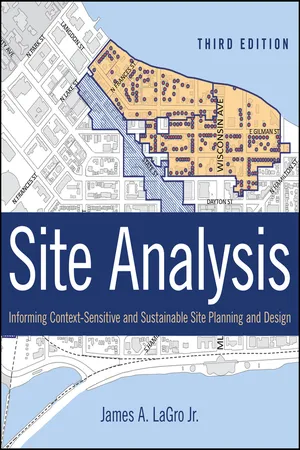
Site Analysis
Informing Context-Sensitive and Sustainable Site Planning and Design
- English
- ePUB (mobile friendly)
- Available on iOS & Android
Site Analysis
Informing Context-Sensitive and Sustainable Site Planning and Design
About this book
The process-oriented guide to context-sensitive site selection, planning, and design
Sustainable design is responsive to context. And each site has a unique set of physical, biological, cultural, and legal attributes that presents different opportunities and constraints for alternative uses of the site. Site analysis systematically evaluates these on-site and off-site factors to inform the design of places—including neighborhoods and communities—that are attractive, walkable, and climate-resilient.
This Third Edition of Site Analysis is fully updated to cover the latest topics in low-impact, location-efficient design and development.
This complete, user-friendly guide:
- Blends theory andpractice from the fields of landscape architecture, urban planning, architecture, geography, and urban design
- Addresses important sustainability topics, including LEED-ND, Sustainable Sites, STAR community index, and climate adaptation
- Details the objectives and visualization methods used in each phase of the site planning and design process
- Explains the influence of codes, ordinances, and site plan approval processes on the design of the built environment
- Includes more than 200 illustrations and eight case studies of projects completed by leading planning and design firms
Site Analysis, Third Edition is the ideal guide for students taking courses in site analysis, site planning, and environmental design. New material includes review questions at the end of each chapter for students as well as early-career professionals preparing for the ARE, LARE, or AICP exams.
Frequently asked questions
- Essential is ideal for learners and professionals who enjoy exploring a wide range of subjects. Access the Essential Library with 800,000+ trusted titles and best-sellers across business, personal growth, and the humanities. Includes unlimited reading time and Standard Read Aloud voice.
- Complete: Perfect for advanced learners and researchers needing full, unrestricted access. Unlock 1.4M+ books across hundreds of subjects, including academic and specialized titles. The Complete Plan also includes advanced features like Premium Read Aloud and Research Assistant.
Please note we cannot support devices running on iOS 13 and Android 7 or earlier. Learn more about using the app.
Information
part I
Context and Approach
Chapter 1
Shaping the Built Environment
Sustainable design balances human needs (rather than human wants) with the carrying capacity of the natural and cultural environments. It minimizes environmental impacts, and it minimizes importation of goods and energy as well as the generation of waste.
1.1 INTRODUCTION
1.2 ECOSYSTEM SERVICES
Transportation costs, markets, and raw materials no longer determine the location of economic activities. We have developed an information-based economy in which dominant economic activities and the people engaged in them enjoy unparalleled locational flexibility. In this spatial context, amenity and ecological considerations are more important locational factors than in the past. Cities located in amenity regions of North America are growing more rapidly than others and such trends will intensify as society becomes more footloose.(Abler et al., 1975, p. 301)
| Function | Goods or Services |
| Production | Oxygen |
| Water | |
| Food and fiber | |
| Fuel and energy | |
| Medicinal resources | |
| Regulation | Storage and recycling of organic matter |
| Decomposition and recycling of human waste | |
| Regulation of local and global climate | |
| Carrier | Space for settlements |
| Space for agriculture | |
| Space for recreation | |
| Information | Aesthetic resources |
| Historic (heritage) information | |
| Scientific and educational information |
- Tropical forests are shrinking, and the rates of plant and animal species extinction are increasing.
- Groundwater tables are falling as water demand exceeds aquifer recharge rates, and groundwater continues to be contaminated with pesticides and other contaminants.
- Global climate change and warming are occurring, and the sea level is projected to rise by as much as 3 feet (0.91 meter) by 2100. Source: http://earthtrends.wri.org/
The really big catastrophes are getting large and will continue to get larger, partly because of things we’ve done in the past to reduce risk. . . . Many of the accepted methods for coping with hazards have been based on the idea that people can use technology to control nature to make them safe.
1.3 PLACE-BASED STEWARDSHIP
Table of contents
- Cover
- Contents
- Title Page
- Copyright
- Dedication
- Preface
- Acknowledgments
- Part I: Context and Approach
- Part II: Predesign and Analysis
- Part III: Design and Implementation
- Appendix A: Mapping and Graphics
- Appendix B: Resources
- Glossary
- References
- Index
- End User License Agreement